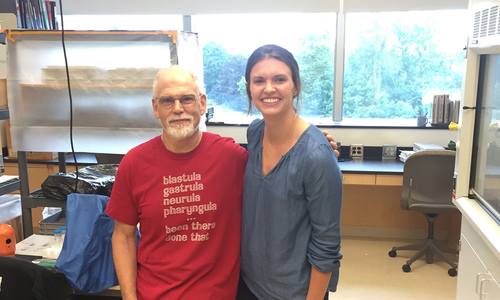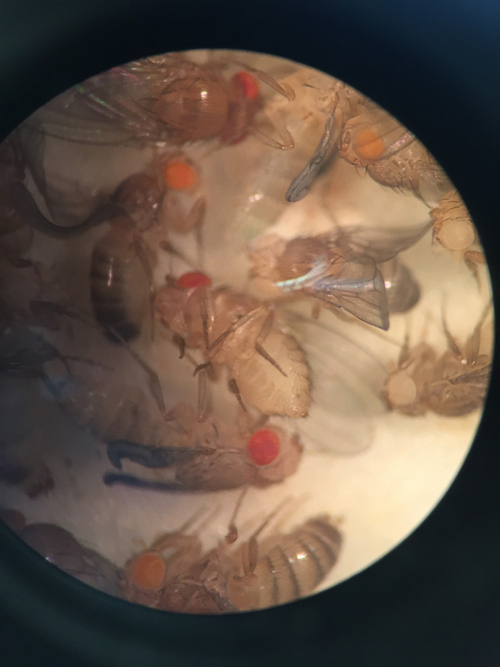The term “fail forward,” might be trending today, but biology Professor Eric Liebl has been teaching his students that concept for years.
“I still remember Dr. Liebl telling us the first part of ‘research’ is ‘re’ as in ‘re-do’,”’ says Hannah Swahn ’16, a former student of Liebl who completed her Ph.D. in genetics at Case Western Reserve University, and is now completing a postdoc at Scripps Research Institute.
“We learn from failed experiments as much as those that succeed,” says Liebl who credits his own undergraduate mentor for the advice. “Every piece of data tells us something and points to a new question.”
Liebl has been teaching and doing research at Denison for almost 30 years. He recently received the Bonar Mentorship and Teaching Excellence Award in recognition of his stellar work with students.
Former students attest to the value of Liebl’s guidance.
“He has a great scientific mentorship style,” says Hannah Brown ’15, who conducted quite a bit of research in Liebl’s lab. “We did a lot of work together, but he also trusted me to work independently.” Brown achieved her Ph.D. in molecular genetics and microbiology from Duke and is currently at Harvard working on a postdoc fellowship.
“He took time to get to know each one of us and understand what motivated us. Then he fine-tuned the research toward what we were interested in,” she adds. “I still talk to him frequently, scientifically, and as a friend and mentor.”
From La Joya, Calif, Swahn says. “Dr. Liebl set me on a path for doing my Ph.D. in genetics — I actually owe it to him. He was so encouraging, and he was instrumental in exposing me to my first real scientific research lab and techniques.”
Liebl doesn’t have a “secret sauce” for research. For him, the steps are clear. “I just follow the molecules.”
The molecules in question are located within Drosophila melanogaster, otherwise known as the common fruit fly. “We do research on fruit flies because they are genetically similar to humans,” Liebl says. “Fruit flies and humans are both diploids, which means they carry two complete sets of chromosomes, one from each parent.”
In fact, the Drosophila genome matches about 60% of the human genome overall and about 75% of the genes responsible for human diseases are present in fruit flies.
Drosophila can be genetically manipulated and observed, and are available in statistically large populations. In other words, they’re an ideal organism for a lot of research.
Liebl’s recent research involves a gene called trio. In research funded by the National Science Foundation, Liebl’s group, collaborating with a fellow research group at The Ohio State University, originally discovered that trio plays a critical role in the development of the fruit fly’s central nervous system, and that a very similar trio gene exists in humans.
More recently, Liebl and his students have discovered that trio also plays a role in the fruit fly’s peripheral nervous system. Larvae with trio mutations have trouble advancing to pupae, and they also responded to being poked and prodded in ways they hadn’t before.
Now a whole new set of questions needs to be answered. And scientific inquiry doesn’t always take place in a lab.
Brown recalls how Liebl and fellow seniors in biology would go to a restaurant, enjoy a meal and beverage, and talk about scientific articles. “He wanted us to really understand the literature,” she says. “It was fun. He talked about how the research could be translated into the real world.”.
In particular, she remembers a fascinating discussion of a research paper on diabetics, whose author Brown later met at Duke University. “I was able to form a relationship with her in part because of those after-class talks with Dr. Liebl,” she says.
During decades of work, Liebl has analyzed countless central nervous systems of Drosophila melanogaster. Now, thanks in part to trio, he is focused on the natural tree-like (or dendritic arbor) pattern of the peripheral nervous system’s sensory neurons — and continues to do research with the fruit fly.
Liebl and his students have been genetically altering the structure of the sensory neurons’ arbors and testing for effects on those neurons’ function.
“The literature reports there are 58 different genes that affect dendritic structures, and so far we have successfully interrogated only two of them,” Liebl says.
It’s important work with the potential to affect lives. “People can have nervous system issues caused by failures to form dendritic structures properly.”
Liebl and his students still have a lot of molecules to follow.



